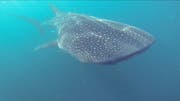The world’s largest gathering of whale sharks visits the warm waters of Qatar every summer. Discover more about these gentle giants and how to admire one of nature’s most spectacular creatures.
WILDLIFE
WILDLIFE
The world’s largest gathering of whale sharks visits the warm waters of Qatar every summer. Discover more about these gentle giants and how to admire one of nature’s most spectacular creatures.
Every year, Qatar’s northeast coast becomes home to one of the world’s largest gatherings of whale sharks in a truly unforgettable sight. Whale sharks are known for their distinctly dotted patterns and camouflaging appearances. If you’re lucky, you can see up to 300 whale sharks rising to the surface to feed, all at once!
Latin name means ‘rasp tooth’.
Females grow larger than males.
Roughly the size of a school bus.
Matures at 25 years and lives 60 to 100 years.
Is a whale shark a whale… or a fish?
With its vast size and confusing name, people are often puzzled whether this endangered species is a breed of whales or sharks. However, a whale shark is not a mammal but a fish. Whale sharks are cold-blooded and breathe through gills, and like other sharks, their skeletal system is made of cartilage, not bone.
Qatar is home to one of the largest congregations of whale sharks on the planet, which congregate in the Al Shaheen region off the north-east coast of Qatar from April to September. Until recently, the area frequented by the whale sharks has been closed to the public, so there are still very few people who have seen them up close. You can book a boat tour with a trained whale shark expert to admire these majestic creatures from a respectful distance.
Every year, whale sharks meander in the warm and shallow sea waters of the Northern coasts of Qatar, located about 145 km from Doha in the Al Shaheen region. The reason why this region attracts so many whale sharks is because of its unique ecosystem. The average seawater temperature averages between 32–34 degrees during the summer months, however the seawater around Al Shaheen is much cooler, making it perfect for fish to feed and breed.
In collaboration with the Qatar Ministry of Environment (MOE), the Qatar Whale Shark Research project began in 2010 to perform research on the whale sharks of Qatar. The research involved attaching satellite trackers and taking ‘fingerprint images’ of the whale sharks. Researchers use special software to identify sharks from their spot patterns. To date, more than 600 individual whale sharks have been identified and recorded in the database, making it the largest aggregation of whale sharks known in the world.
No, to protect the whale sharks and their habitat, no swimming, touching or feeding of sharks is allowed.
Yes, whale sharks are currently listed as Endangered on the IUCN Red List. Their global population has declined by more than 50% over the past 75 years.
No, whale sharks are gentle giants that don’t pose a risk to humans. They don’t hunt like sharks but are filter feeders, snacking on small prey such as plankton, crustaceans and squid.
Want to travel visa-free? Check if you qualify here.
Planning your trip to Qatar? Check how to get here.
Make the most of your visit with our handy travel guide.
From a dhow boat to our world-class metro, here’s how to easily explore Qatar.
